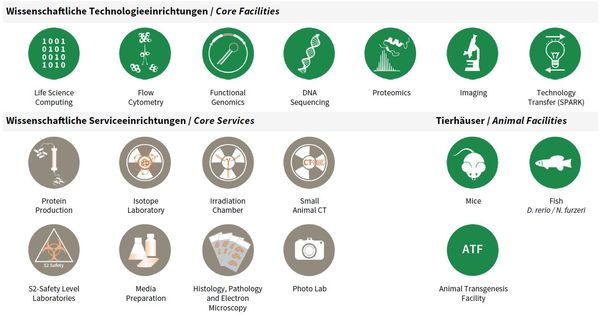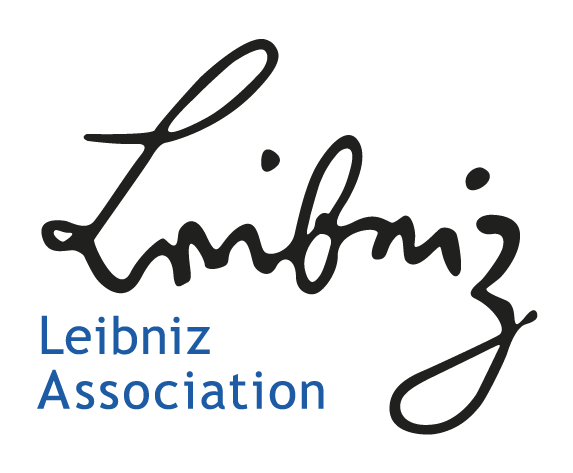Core Facilites and Core Services
At the beginning of 2016, a “core” structure was put into effect that organized facility and service units as independent organizational entities from FLI’s research groups. A number of technology platforms (e.g. sequencing, mass spectrometry) grew out of individual methodological requirements for single research groups in the last years but developed into semiautonomous substructures. As consequence of re-focused research activities and the concomitant advent of new research groups at FLI, those units increasingly had to serve many FLI groups and collaborative research efforts in the Jena research area.
To accommodate this development and to increase efficiency as well as transparency for users, facility personnel and for administrative processes, it came natural to re-organize such activities into independent units as “FLI Core Facilities and Services” and to phase out infrastructures considered non-essential for FLI’s research focus (X-ray crystallography and NMR spectroscopy).
FLI’s Core Facilities (CF) are managed by a CF Manager and are each scientifically guided in their activities and development by an FLI Group Leader, as Scientific Supervisor. The animal facilities comprising fish, mouse and transgenesis are run separately, as they involve a more complex organizational structure. Basic Core Services (CS) are directly led by the Head of Core (HC), who in turn is supported by individual CS Managers.
All facilities and services, including animal facilities, have a valuable contribution to FLI’s research articles; e.g. from 2016–2018, to 54% of all peer reviewed research publications.
Overview Core Facilities and Core Services at FLI.
Publications
(since 2016)
2016
- Genotyping of herpes simplex virus type 1 by whole-genome sequencing.
Pfaff F, Groth M, Sauerbrei A, Zell R
J Gen Virol 2016, 97(10), 2732-41 - Anti-amyloid compounds protect from silica nanoparticle-induced neurotoxicity in the nematode C. elegans.
Scharf A, Gührs KH, von Mikecz A
Nanotoxicology 2016, 10(4), 426-35 - Genetic Factors of the Disease Course after Sepsis: A Genome-Wide Study for 28Day Mortality.
Scherag A, Schöneweck F, Kesselmeier M, Taudien S, Platzer M, Felder M, Sponholz C, Rautanen A, Hill AVS, Hinds CJ, Hossain H, Suttorp N, Kurzai O, Slevogt H, Giamarellos-Bourboulis EJ, Armaganidis A, Trips E, Scholz M, Brunkhorst FM
EBioMedicine 2016, 12, 239-46 - An atomic model of HIV-1 capsid-SP1 reveals structures regulating assembly and maturation.
Schur FKM, Obr M, Hagen WJH, Wan W, Jakobi AJ, Kirkpatrick JM, Sachse C, Kräusslich HG, Briggs JAG
Science 2016, 353(6298), 506-8 published during change of institution - Epidermal Nbn deletion causes premature hair loss and a phenotype resembling psoriasiform dermatitis.
Seidel P, Remus M, Delacher M, Grigaravicius P, Reuss DE, Frappart L, von Deimling A, Feueuer M, Abdollahi A, Frappart PO
Oncotarget 2016, 7(17), 23006-18 - Genetic Factors of the Disease Course After Sepsis: Rare Deleterious Variants Are Predictive.
Taudien* S, Lausser* L, Giamarellos-Bourboulis EJ, Sponholz C, Schöneweck F, Felder M, Schirra LR, Schmid F, Gogos C, Groth S, Petersen BS, Franke A, Lieb W, Huse K, Zipfel PF, Kurzai O, Moepps B, Gierschik P, Bauer M, Scherag A, Kestler** HA, Platzer** M
EBioMedicine 2016, 12, 227-38 * equal contribution, ** co-senior authors - PARP activation promotes nuclear AID accumulation in lymphoma cells.
Tepper S, Jeschke J, Böttcher K, Schmidt A, Davari K, Müller P, Kremmer E, Hemmerich P, Pfeil I, Jungnickel B
Oncotarget 2016, 7(11), 13197-208 - Stress promotes Arabidopsis - Piriformospora indica interaction.
Vahabi K, Dorcheh SK, Monajembashi S, Westermann M, Reichelt M, Falkenberg D, Hemmerich P, Sherameti I, Oelmüller R
Plant Signal Behav 2016, 11(5), e1136763 - TraqBio - Flexible Progress Tracking for Core Unit Projects.
Völkel G, Wiese S, Holzmann K, Kraus JM, Schneider F, Görlach M, Kestler HA
PLoS One 2016, 11(9), e0162857 - Characterization of SKAP/Kinastrin isoforms - The N-terminus defines tissue specificity and Pontin binding.
Vranesic AC, Reiche J, Hoischen C, Wohlmann A, Bratsch J, Friedrich K, Günes B, Cappallo-Obermann H, Kirchhoff C, Diekmann S, Günes C, Huber O
Hum Mol Genet 2016, 25(13), 2838-52









